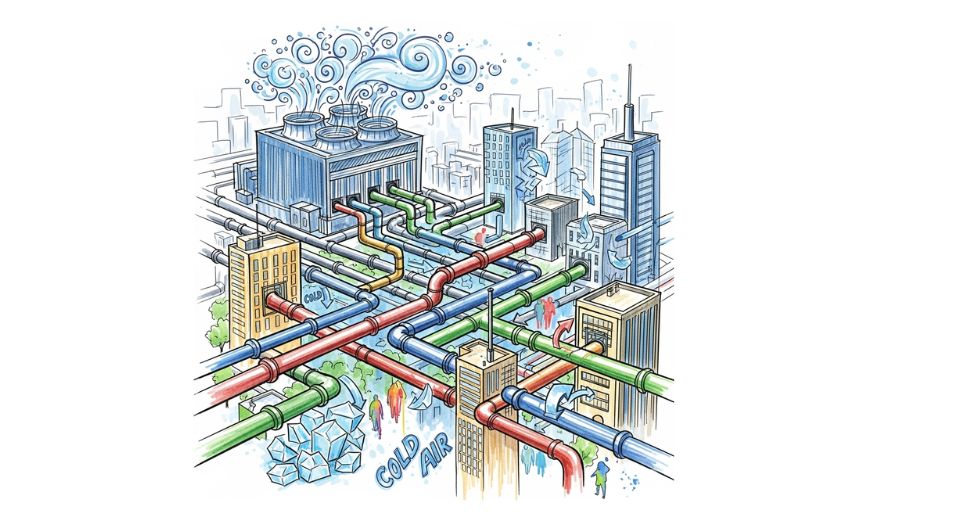
Aug 04, 2025

The most recent report by Metastat Insight provides a profound and multifaceted insight into the prevailing direction and future potential of the Global District Cooling Market. With a refined emphasis on regional and global trends, the report provides a unified explanation of the manner in which the market is evolving in its larger environmental, economic, and technological contexts. This report does not only skim the surface of superficial comments but drowns readers in a holistic story which emphasizes the industry's dynamic presence in urban infrastructure and its engagement with sustainability objectives.
Underpinning the market's development is a shift in how populous cities approach energy consumption and urban planning. District cooling, which works on the system of central production and distribution of cooling energy, has started to impact the architectural and environmental profile of cities. Urban areas that previously relied extensively on decentralized air conditioning systems are rethinking their strategy. This shift is not incidental; rather, it is reflective of broader changes in regulatory frameworks, urban policies, and strategic planning initiatives that view energy efficiency as a long-term investment rather than an optional enhancement.
There is also a notable shift in how stakeholders ranging from government bodies to private-sector collaborators view infrastructure longevity and operational costs. District cooling is not only being adopted for its technical quality but also for its capability to blend into lasting urban sustainability plans. What one finds reflected in the research of Metastat Insight is the increasing number of projects with environmental balance, system robustness, and long-term cost savings as non-negotiable goals. This increasing awareness is calling for increased synergy between district cooling companies and urban planners, emerging in integrated planning procedures where district cooling has a crucial role right from the initial blueprint stage of construction.
The difference that characterizes today's climate compared to past phases of market development is the degree of localization and customization in project design. No longer restricted by cookie-cutter approaches, the Global District Cooling Market is observing increased context-based solutions that fit the climatic, economic, and architectural requirements of various regions. This extent of fineness not only highlights the technical proficiency of industry players but also indicates an adaptive approach aimed at optimizing utility with a focus on retaining regional identity.
The development of district cooling business models has also been the focus of active interest. Financing arrangements, contractual agreements, and operating schemes alike are being re-engineered to accommodate new stakeholder aspirations. While earlier models tended to focus on short-term deliverables, there is increasingly an evident lean towards solutions focusing on lifecycles. Such models seek to integrate technological investment with long-term operational efficiency, typically underpinned by performance warranties and upgraded measures of service delivery.
From the technological angle, digital transformation is transforming the way systems are monitored, optimized, and maintained quietly but consistently. Advanced control systems, predictive analytics, and real-time monitoring of data have become central to ensuring consistency of performance and opportunities for system enhancement. Such tools, previously viewed as nice-to-have add-ons, are now central to competitiveness in the Global District Cooling Market. Their enactment not only enhances system reliability but also reinforces stakeholder confidence in long-term operation pledges.
Yet another angle the Metastat Insight report places center stage is the changing discourse around environmental accountability. The discourse has shifted from mere compliance with emissions regulations to an expanded goal of proactive support to climate objectives. District cooling technologies are increasingly being judged not just by their energy savings but by their overall ecological footprint, including water usage, land utilization, and integration with renewable sources. The expectation is that these systems not only perform efficiently but also do so with minimal ecological disruption.
Urban densification continues to shape the physical context in which district cooling systems are deployed. With urban space becoming ever scarcer, there has been greater importance placed on keeping systems compact, underground, or modular. They are planned to fit smoothly into the current topology without necessitating widespread reconstruction or relocation, something that is especially attractive for mature urban infrastructure cities. This in mind, system design has become more scalable and non-intrusive.
What cannot be ignored is the influence of public awareness and people's participation in determining project success. While district cooling might otherwise be a technical topic, its success is frequently dependent on public acceptance and user satisfaction. Planners and providers are investing more in communication strategies framing the concrete advantages of these systems in terms of comfort, cost savings, and environmental responsibility. This people-oriented methodology not only enhances take-up but also inspires a collective sense of ownership and accountability.
In its considered explanation of multilayered facts and regionally differentiated insights, the Global District Cooling Market Report compiled by Metastat Insight is a useful guide to comprehending the industry's richly textured development. Its examination of how cities are being reconfigured through efficient cooling infrastructure is a sector that is much more than a utility it is a keystone to sustainable lifestyle and progressive city planning. As energy transition narratives become more profound, so does the sector of district cooling in shaping cities of the future, not just as an engineering innovation but as a modern urban planning force for change.
Drop us an email at:
Call us on:
+1 214 613 5758
+91 73850 57479